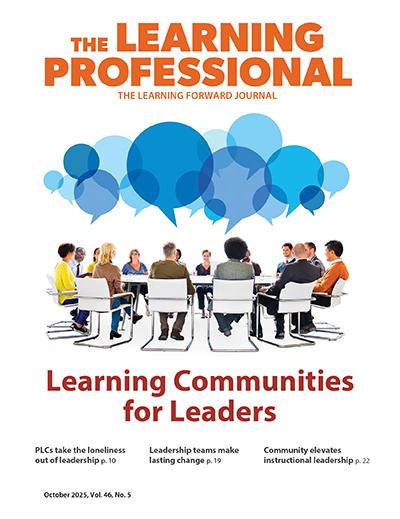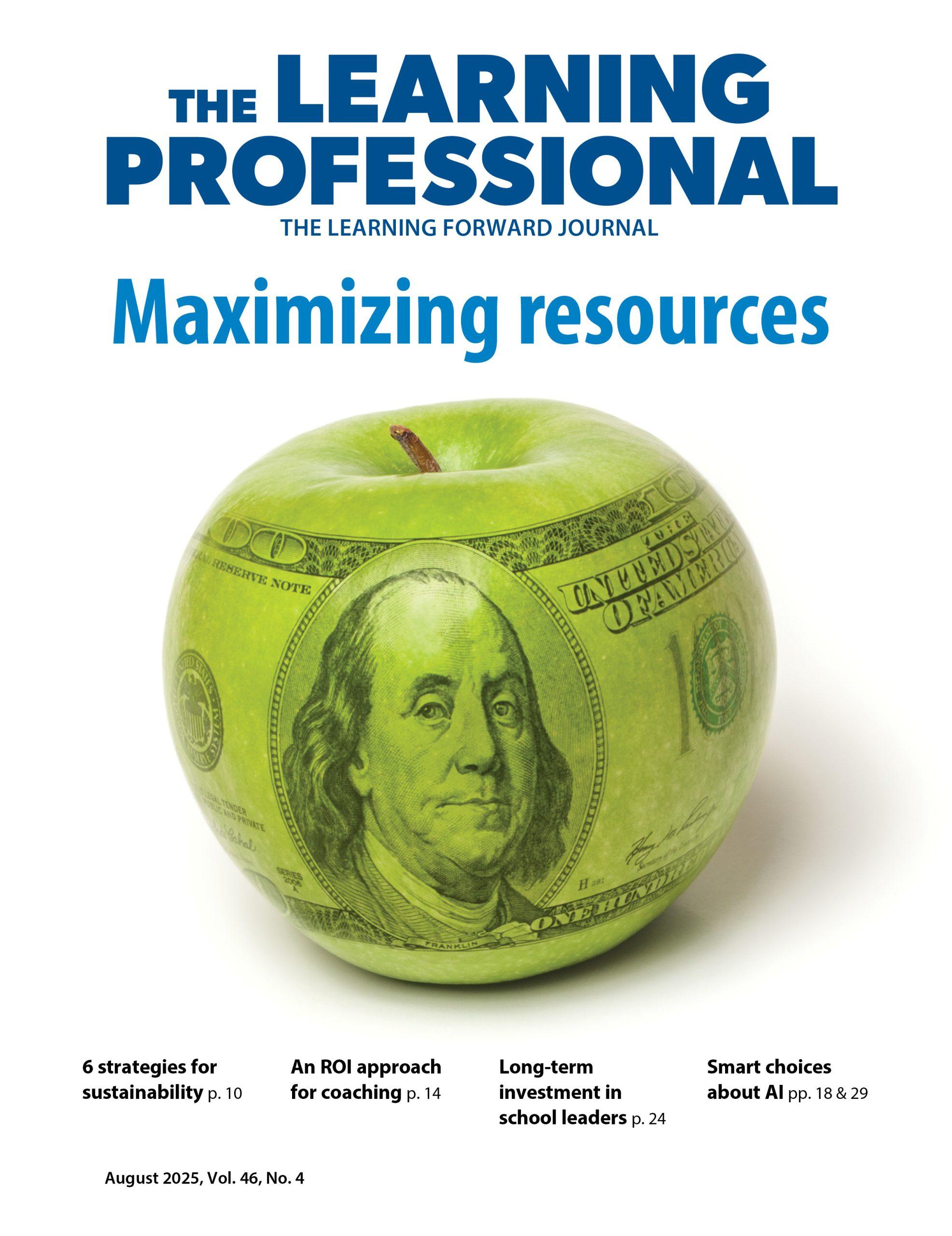Rounds Process Puts Teachers In Charge of Learning
By Learning Forward
Categories: Learning designs, Standards for Professional LearningApril 2014
Read the remaining content with membership access. Join or log in below to continue.
Sed ut perspiciatis unde omnis iste natus error sit voluptatem accusantium doloremque laudantium, totam rem aperiam, eaque ipsa quae ab illo inventore veritatis et quasi architecto beatae vitae dicta sunt explicabo. Nemo enim ipsam voluptatem quia voluptas sit aspernatur aut odit aut fugit, sed quia consequuntur magni dolores eos qui ratione voluptatem sequi nesciunt. Neque porro quisquam est, qui dolorem ipsum quia dolor sit amet, consectetur, adipisci velit, sed quia non numquam eius modi tempora incidunt ut labore et dolore magnam aliquam quaerat voluptatem.

Alignment Of Teacher Rounds To Standards For Professional Learning
| STANDARD | CONNECTION TO ROUNDS |
|
Learning Communities
Core elements: Engage in continuous improvement. Develop collective responsibility. Create alignment and accountability. |
Commits to collective improvement through observations, feedback, and targeted action.
Focuses on “our” students instead of “my” students. Adjusts and improves practice, holding all participants accountable for their work. |
|
Leadership
Core elements: Develop capacity for learning and leading. Advocate for professional learning. Create support systems and structures. |
Builds capacity of teachers to serve as facilitators.
Defines the role of facilitator; requires the skills of a teacher leader. Develops a culture in which teachers are willing to make their practice public and transparent. Creates collaborative structures for work with peers to support mutual learning through rounds. |
|
Resources
Core elements: Prioritize human, fiscal, material, technology, and time resources. Monitor resources. Coordinate resources. |
Uses internal resources by developing teachers to learn with and from each other.
Experiments with and monitors new teaching strategies in classroom teaching. Achieves the highest levels of return for teachers and students through a low-cost, high-impact professional learning initiative. |
|
Data
Core elements: Analyze student, educator, and system data. Assess progress. Evaluate professional learning. |
Gives teachers opportunities to collect data from students and peers during an observation.
Develops teachers’ capacity to assess instruction and analyze results. Evaluates professional learning by using records of practice as a focus tool for teacher learning. Uses data from student and teacher classroom practice. |
|
Learning Designs
Core elements: Apply learning theories, research, and models. Select learning designs. Promote active engagement. |
Provides job-embedded collaborative learning.
Encourages teachers to voice their concerns about their teaching; teachers are receptive to learning from one another. Offers group-developed online resources in Google Docs; includes videos and records of practice. Implements facilitator coaching. Specifies professional reading. |
|
Implementation
Core elements: Apply change research. Sustain implementation. Provide constructive feedback. |
Applies change research; teachers create an action plan, take action in their classrooms, refine action based on feedback.
Provides ongoing professional learning for teachers regardless of years in the field; recognizes the importance of continuous improvement for all teachers. Extends, refines, and sustains learning through specific feedback. |
|
Outcomes
Core elements: Meet performance standards. Address learning outcomes. Build coherence. |
Aligns with Common Core as well as any school or district initiative; can be focused on implementation of the initiative.
Reinforces teachers’ observation and analysis skills; coordinates these to adjust practice and assess growth. Links professional learning to student learning with a focus on student content standards. |
| Source: Adapted from Learning Forward. (2011). Standards for Professional Learning, p. 61. Oxford, OH: Author. |
Host Teacher Preparation Form
| 1 | Review or explain the problem of practice. |
| With the goal of building on number relationships to solve problems while building efficient strategies, we will investigate how we use Number Talks to plan math discussions that enable students with different math abilities to explain their thinking and build fluency. | |
| 2 | Provide context for the lesson. |
| What is the task? | |
|
Using mental math, students will solve the equation 368+191.
Students show a visual cue when they are ready with a solution, and students signal if they have found more than one way to solve the problem. This form allows students to think, while the process continues to challenge those that already have an answer. I collect answers correct/incorrect and record answers. Students share their strategies and thinking with their peers. |
|
| What is your role as the teacher? | |
| My role is to act as a facilitator, questioner, recorder, and learner in addition to creating a safe and accepting classroom community. | |
| What are the students going to be doing? | |
| Students will reason with numbers and make mathematically convincing arguments. Students will be listening to their peers’ responses and sharing mental math strategies. | |
| 3 | On what should the observers focus their attention? |
| How do I listen to and follow students’ math thinking? | |
| How do I encourage and value student communication? | |
| What conditions are present that foster a safe learning community? |
References
Learning Forward. (n.d.-a). Definition of professional development. Available at https://learningforward.org/who-we-are/professional-learning-definition.
Learning Forward. (n.d.-b). Standards for Professional Learning. Available at https://learningforward.org/standards.
Mizell, H. (2008, July). NSDC’s definition of professional development: The second dimension. Remarks at a meeting of NSDC’s state affiliate leaders, Orlando, FL.
Troen, V. & Boles, K.C. (in press). The power of Teacher Rounds: A guide for facilitators, principals, & department chairs. Thousand Oaks, CA: Corwin Press & Learning Forward.
Learning Forward is the only professional association devoted exclusively to those who work in educator professional development. We help our members plan, implement, and measure high-quality professional learning so they can achieve success with their systems, schools, and students.
Categories: Learning designs, Standards for Professional Learning
Recent Issues
MAXIMIZING RESOURCES
August 2025
This issue offers advice about making the most of professional learning...
MEASURING LEARNING
June 2025
To know if your professional learning is successful, measure educators’...
NAVIGATING NEW ROLES
April 2025
Whether you’re new to your role or supporting others who are new,...
LEARNING DESIGNS
February 2025
How we learn influences what we learn. This issue shares essential...









